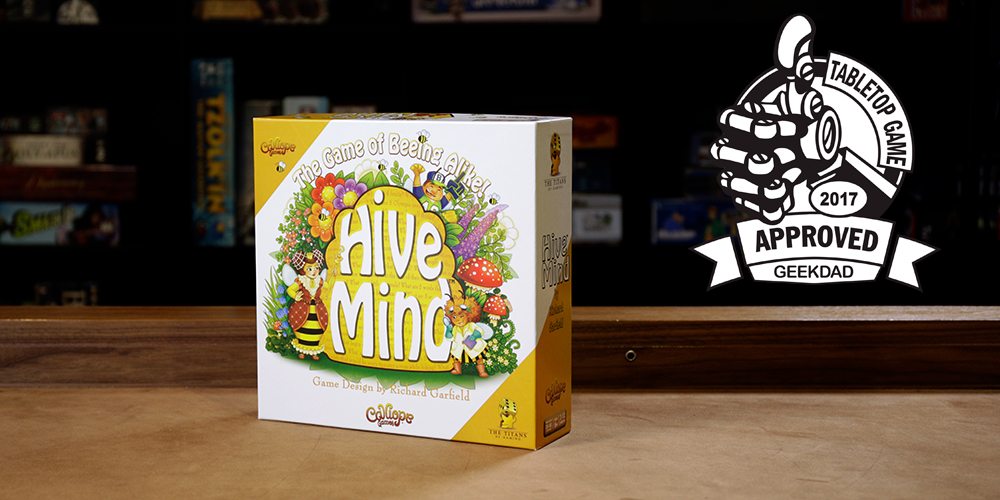Magnets are fun to play with: there’s something almost magical (okay, I know, it’s scientific) about the way they push and pull — especially when the magnets are hidden. Last year I wrote about The Magic Labyrinth, a kids’ game from Playroom Entertainment that used magnets to create invisible walls. Here I’ve got two more games from the same line. They’re not brand new, but they’re still great if you’ve got kids in the right age range. Both were nominated for the Kinderspiel des Jahres (children’s game of the year).
Overview: First up: Magician’s Kitchen has you working as the magician’s assistants, delivering ingredients to the proper cauldrons and then starting up the fire. But beware! Although the floor seems smooth, the embedded magnet will cause you to trip if you cross the wrong path, spilling your ingredients and sending you back to your work table. Be the first to deliver all four ingredients and then light the fire to win the game.
Ages: 5 and up
Playing Time: 20 minutes
Retail:
Rating: It’s a trip! Fun for little kids, not too interesting for grown-ups.
Who Will Like It? This is one that’s best for younger kids — say up to about ten or so. Beyond that I think it starts to lose a bit of the challenge.
Components:
- 16 wooden marbles (ingredients)
- 1 marble (fireball)
- 4 assistant pawns
- 4 wands
- fireplace
Like Magic Labyrinth, the box is integrated into the board: the four corners have little wells that act as the cauldrons for ingredients, with a simple cardboard backer that indicates the color of each corner and holds up the corner edges of the box lid. The fireplace is a clever little plastic doohickey with a cardboard arch over it that holds the fireball marble. It’s designed so that when the marble lands in the center, the orange “flames” pop up (as you can see in the photo at the very top of the post).
The pawns are plastic with a little scoop on the top that holds the wooden marbles somewhat precariously, and you’ll notice that the bottom front edge is angled up slightly. That’s where the magnet is hidden, so that when it is tripped, the pawn snaps forward and dumps the ingredient. The little wands are just wooden sticks that you use to push the pawns around so you can’t hold onto them and keep them from tripping.
The board is a large plastic insert with a cardboard layer on top, and looking at the underside shows how it all works. There are eight little wells that hold steel bearings in specific places: these correspond to the “magic stones” on the board, marked with purple stars. There are also four bearings in larger U-shaped sections which each have nine small dimples. At the beginning of the game, you shake the board so that these four bearings settle randomly into their places, one in each quadrant of the board, and these form the places where the assistants can trip.
Gameplay:
Each player takes an assistant and a wand, and the four colored ingredients are placed in the holes on the board. Taking turns, each player chooses an ingredient, puts in on top of their assistant pawn, and then tries to push the pawn to the correct cauldron in the corners of the board. If the pawn reaches the “magic stone” it will tip forward, ideally tipping the ingredient into the cauldron. (Though if the orientation isn’t correct, sometimes it will fling it off to the side.)
If the assistant passes over any of those hidden bearings, it will trip and spill the ingredient, and the turn is over.
After you have delivered all four of your ingredients, you get to take the fireball marble from the fireplace arch and deliver it to the fireplace, lighting the flames. Do that successfully, and you win!
There is a catch-up mechanism as well: if any player has already placed all of their ingredients into cauldrons, you may now carry two ingredients at once, and they can go into either of the possible cauldrons.
Conclusion:
The game is fairly simple, and since there’s only one tripping point in each quadrant of the board, it’s pretty easy to remember where they are after the first trip. As long as you push the assistant along slowly, it’s pretty easy to control, though for smaller children this is pretty good practice at fine motor skills. In this case, there’s not a ton of strategy — it’s more about dexterity, luck, and memory — but the way the pawns tip forward when you hit the bearings is pretty fun, and really simulates tipping ingredients into cauldrons or tripping on a stone.
The artwork is in the same vein as Magic Labyrinth and is pretty cute. My kids get pretty invested in which assistant represents them best.
I can’t see it holding the interest of older kids for much, but my five-year-old and eight-year-old enjoy playing it and I’ve sat down with them from time to time. It’s a pretty short game, too, so it’s not terrible if you get recruited to play.
Wired: Fun magnetic pawns “trip” over stones. Easy to learn.
Tired: May not hold interest of older players.







